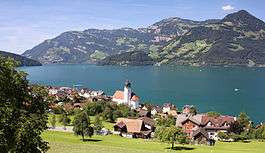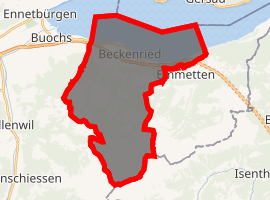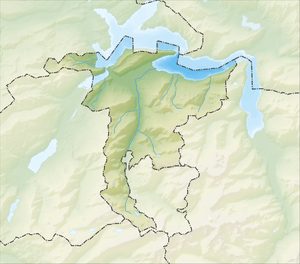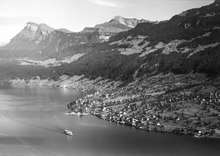Beckenried
Beckenried is a municipality in the canton of Nidwalden in Switzerland.
Beckenried | |
|---|---|
 | |
 Coat of arms | |
Location of Beckenried 
| |
 Beckenried  Beckenried | |
| Coordinates: 46°58′N 8°28′E | |
| Country | Switzerland |
| Canton | Nidwalden |
| District | n.a. |
| Area | |
| • Total | 32.95 km2 (12.72 sq mi) |
| Elevation | 435 m (1,427 ft) |
| Population (2018-12-31)[2] | |
| • Total | 3,672 |
| • Density | 110/km2 (290/sq mi) |
| Postal code | 6375 |
| SFOS number | 1501 |
| Surrounded by | Buochs, Emmetten, Ennetbürgen, Gersau (SZ), Isenthal (UR), Oberdorf, Wolfenschiessen |
| Website | www SFSO statistics |
History
The first settlers in what would become Beckried were from Alamanni tribes that moved into the area over 2000 years ago.[3] During the Middle Ages the region was part of extensive estates that were shared between Engelberg Abbey, Murbach-Lucerne and Steinen, Switzerland. The two tower houses in the village (named: Retschrieden and Isenringen) were built in the 13th century for two local, influential families. In 1262 the village is mentioned in an agreement over a nearby pasture.[3] In 1314 it is mentioned as Beggenriet.[4]
Geography

Beckenried has an area, (as of the 2004/09 survey) of 24.23 km2 (9.36 sq mi).[5] Of this area, about 48.7% is used for agricultural purposes, while 37.3% is forested. Of the rest of the land, 6.1% is settled (buildings or roads) and 7.9% is unproductive land. In the 2004/09 survey a total of 78 ha (190 acres) or about 3.2% of the total area was covered with buildings, an increase of 25 ha (62 acres) over the 1981 amount. Of the agricultural land, 6 ha (15 acres) is used for orchards and vineyards, 432 ha (1,070 acres) is fields and grasslands and 841 ha (2,080 acres) consists of alpine grazing areas. Since 1981 the amount of agricultural land has decreased by 30 ha (74 acres) and the amount of forested land has increased by 21 ha (52 acres). Rivers and lakes cover 9 ha (22 acres) in the municipality.[6][7]
The municipality is a linear village along the shore of Lake Lucerne. It consists of the village of Beckenried with the sections known as Oberdorf, Niederdorf and Dorf.
The Beckenried–Gersau car ferry links a terminal in Niederdorf with Gersau on the opposite bank of Lake Lucerne.
Demographics

Beckenried has a population (as of December 2018) of 3,672.[8] As of 2015, 12.6% of the population are resident foreign nationals of which a small minority (182 or 5.1% of the total population) was born in Germany.[9] Over the last 5 years (2010-2015) the population has changed at a rate of 6.88%. The birth rate in the municipality, in 2015, was 12.3, while the death rate was 6.3 per thousand residents.[7]
As of 2015, children and teenagers (0–19 years old) make up 20.7% of the population, while adults (20–64 years old) are 61.7% of the population and seniors (over 64 years old) make up 17.6%.[7] In 2015 there were 1,525 single residents, 1,582 people who were married or in a civil partnership, 173 widows or widowers and 264 divorced residents.[10]
In 2015 there were 1,541 private households in Beckenried with an average household size of 2.27 persons. In 2015 about 34.8% of all buildings in the municipality were single family homes, which is about the same as the percentage in the canton (35.5%) and much less than the percentage nationally (57.4%).[11] Of the 721 inhabited buildings in the municipality, in 2000, about 40.5% were single family homes and 39.3% were multiple family buildings. Additionally, about 27.5% of the buildings were built before 1919, while 14.3% were built between 1991 and 2000.[12] In 2014 the rate of construction of new housing units per 1000 residents was 10.14. The vacancy rate for the municipality, in 2016, was 0.48%.[7]
Most of the population (as of 2000) speaks German (95.3%), with English being second most common (1.0%) and Serbo-Croatian being third (0.8%).[13]
The historical population is given in the following chart:[14][4]

Notable sights and recreation
The main sights of Beckenried are: the church St. Heinrich and its cemetery chapel, the Ridli chapel, the chapel St. Anna, the Klewen chapel, fun fair (Älplerkilbi), and the St. Nikolas market. The urban village of Beckenried and the hamlet of Ridli are both part of the Inventory of Swiss Heritage Sites.[15]
Starting from Beckenried the longest cable car in central Switzerland[16] brings tourists up to Klewenalp, a major holiday resort both in winter and in summer.
Economy
Beckenried is classed as a suburban community.[17]
As of 2014, there were a total of 1,167 people employed in the municipality. Of these, a total of 158 people worked in 49 businesses in the primary economic sector. The secondary sector employed 258 workers in 42 separate businesses, of which 6 businesses employed a total of 147 employees. Finally, the tertiary sector provided 751 jobs in 174 businesses.[18] In 2015 a total of 10.1% of the population received social assistance.[7]
In 2011 the unemployment rate in the municipality was 0.6%.[19]
In 2015 local hotels had a total of 27,293 overnight stays, of which 35.4% were international visitors.[20] In 2015 there was one movie theater in the municipality with 198 seats.[21]
In 2015 the average cantonal, municipal and church tax rate in the municipality for a couple with two children making CHF 80,000 was 3.2% while the rate for a single person making CHF 150,000 was 11.2%, both of which are close to the average for the canton. The canton has a slightly lower than average tax rate for those making CHF 80,000 and one of the lowest for those making CHF 150,000. In 2013 the average income in the municipality per tax payer was CHF 84,038 and the per person average was CHF 38,483, which is less than the cantonal average of CHF 98,342 and CHF 46,206 respectively In contrast, the national tax payer average is CHF 82,682, while the per person average is CHF 35,825.[22]
Politics
In the 2015 federal election the only major party which ran a candidate was the SVP which received 83.9% of the vote. In the federal election, a total of 1,492 votes were cast, and the voter turnout was 58.8%.[23]
In the 2011 federal election the most popular party was the SVP with 48.1%, followed by the FDP with 34.1% and the GPS with 17.8%.[24]
In the 2007 federal election the most popular party was the FDP which received 87.7% of the vote. The next three most popular parties were the local small left-wing parties (10.9%), a catch-all other category (1.4%) and the CVP (0.1%).[13]
Education
In Beckenried about 75.2% of the population (between age 25–64) have completed either non-mandatory upper secondary education or additional higher education (either university or a Fachhochschule).[13]
References
- "Arealstatistik Standard - Gemeinden nach 4 Hauptbereichen". Federal Statistical Office. Retrieved 13 January 2019.
- "Ständige Wohnbevölkerung nach Staatsangehörigkeitskategorie Geschlecht und Gemeinde; Provisorische Jahresergebnisse; 2018". Federal Statistical Office. 9 April 2019. Retrieved 11 April 2019.
- City of Beckenridge website Archived 20 October 2007 at Archive.today accessed 4 November 2008 (in German)
- Beckenried in German, French and Italian in the online Historical Dictionary of Switzerland.
- Arealstatistik Standard - Gemeindedaten nach 4 Hauptbereichen
- "Arealstatistik Land Use - Gemeinden nach 10 Klassen". www.landuse-stat.admin.ch. Swiss Federal Statistical Office. 24 November 2016. Retrieved 27 December 2016.
- Regionalporträts 2017: Swiss Federal Statistical Office (in German) accessed 18 May 2017
- Swiss Federal Statistical Office - STAT-TAB, online database – Ständige und nichtständige Wohnbevölkerung nach institutionellen Gliederungen, Geburtsort und Staatsangehörigkeit (in German) accessed 23 September 2019
- Federal Statistical Office - Ständige und nichtständige Wohnbevölkerung nach institutionellen Gliederungen, Geburtsort und Staatsangehörigkeit (Land) accessed 31 October 2016
- Swiss Federal Statistical Office - Ständige und nichtständige Wohnbevölkerung nach institutionellen Gliederungen, Geschlecht, Zivilstand und Geburtsort (in German) accessed 8 September 2016
- Statistical Atlas of Switzerland - Anteil Einfamilienhäuser am gesamten Gebäudebestand, 2015 accessed 18 May 2017
- Swiss Federal Statistical Office STAT-TAB - Thema 09 - Bau- und Wohnungswesen (in German) accessed 5 May 2016
- Swiss Federal Statistical Office Archived 5 January 2016 at the Wayback Machine accessed 4 September 2009
- Swiss Federal Statistical Office STAT-TAB Bevölkerungsentwicklung nach institutionellen Gliederungen, 1850-2000 (in German) accessed 27 April 2016
- "Swiss inventory of cultural property of national and regional significance". A-Objects. Federal Office for Cultural Protection (BABS). 1 January 2017. Archived from the original on 28 June 2010. Retrieved 6 September 2017.
- Beckenreid Tourism accessed 4 November 2008 (in German)
- "Die Raumgliederungen der Schweiz 2016" (in German, French, Italian, and English). Neuchâtel, Switzerland: Swiss Federal Statistical Office. 17 February 2016. Retrieved 14 December 2016.
- Federal Statistical Office -Arbeitsstätten und Beschäftigte nach Gemeinde, Wirtschaftssektor und Grössenklasse accessed 31 October 2016
- "Arbeitslosenquote 2011". Statistical Atlas of Switzerland. Swiss Federal Statistical Office. Retrieved 4 May 2017.
- Federal Statistical Office - Hotellerie: Ankünfte und Logiernächte der geöffneten Betriebe accessed 31 October 2016
- Swiss Federal Statistical Office - Kinoinfrastruktur nach Gemeinde und Kinotyp Archived 26 September 2016 at the Wayback Machine (in German) accessed 9 August 2016
- "18 - Öffentliche Finanzen > Steuern". Swiss Atlas. Swiss Federal Statistical Office. Retrieved 26 April 2017.
- "Nationalratswahlen 2015: Stärke der Parteien und Wahlbeteiligung nach Gemeinden" [National council elections 2015: strength of the parties and voter turnout by municipality] (in German). Swiss Federal Statistical Office. Archived from the original on 2 August 2016. Retrieved 18 July 2016.
- Swiss Federal Statistical Office - Nationalratswahlen 2011: Parteistärken, Wahlbeteiligung, fiktive Wählende Archived 14 November 2013 at the Wayback Machine (in German) accessed 2 May 2016
| Wikimedia Commons has media related to Beckenried. |
External links
- Beckenried in German, French and Italian in the online Historical Dictionary of Switzerland.
- Beckenried Tourism (in German)